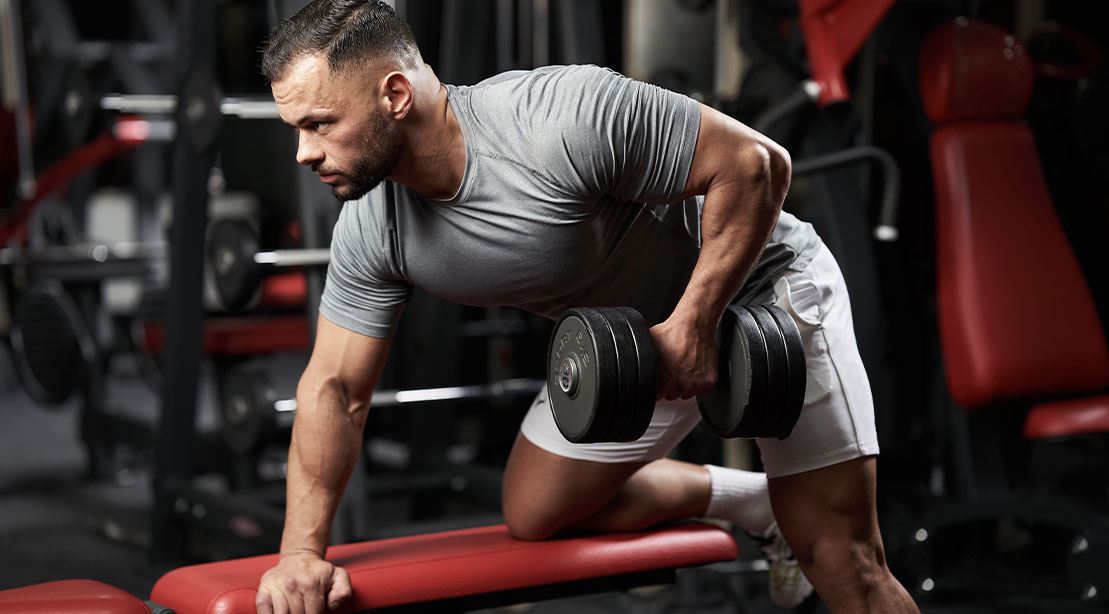A popular and true saying has been floating around the weight room for a while: You got to row to grow. It doesn’t matter if it is vertical or horizontal, and it doesn’t matter what equipment you use. You must train your posterior delts, upper back, and lats hard and heavy as your wings depend on them.
However, the dumbbell row and its variations are great for attacking strength imbalances between sides and even muscle development. Even though they are good for you, they can get dull when you feel you have performed every variation. And that’s where the unilateral row with rotation steps in. Adding a twist at the end of your row provides extra juice for your upper back for sweet gains and helps you break out of your row rut.
This innovative variation is the brainchild of Dr. Justin Farnsworth, a renowned strength coach, educator, and doctor of physical therapy. Farnsworth’s extensive knowledge and experience identified a common issue among his clients and devised this fantastic row variation as a solution.
What Makes The Unilateral Row With Rotation Effective
According to Farnsworth, here’s why we all need a steady dose of unilateral rows.
“The single-arm dumbbell row allows you to handle heavy loads, a key factor in building strength and muscle. You’ll lift heavy weights and effectively challenge your lats, traps, and rhomboids.
But the real magic of this exercise lies in its impact on your shoulder health. When you perform a unilateral dumbbell row, you’re not just pulling the weight up but also training your external rotators as you move into the concentric phase of the lift. This movement pattern is crucial because it trains the muscles responsible for stabilizing your shoulder joint.
Think of it this way: every rep of a single-arm dumbbell row is like a two-for-one deal. You’re building a strong, muscular back while enhancing shoulder stability—a combination essential for anyone who wants to lift heavy for years to come. This makes the single-arm dumbbell row an exercise necessary for long-term upper body health.” says Farnsworth.
The Unilateral Row With Rotation
When Farnsworth saw his clients struggle with thoracic rotation and upper body health, he decided to take action. Now, you can benefit from the doctor’s knowledge and expertise. “The unilateral dumbbell row with rotation is a fun variation that adds more rotation from the shoulder and torso. Set this up like any regular row and perform as usual. However, once you reach the top (when the DB usually stops), allow that rotation to continue into the mid and upper back. This is a great option to add novelty to the horizontal pull and load thoracic rotation, especially for clients/patients with T-spine mobility issues.
This has an added component of thoracic spine rotation, which will also drive the same side shoulder blade into a higher retraction level, increasing its ROM. It also has the added benefit of simply adding in rotation compared to the bent-over row, where we avoid rotation; ultimately, it’s a higher-level exercise,” explains Farnsworth.
Single-Arm Dumbbell Row Form Tips
Farnsworth explains that you must rotate from the chest, not the lower back. As you rotate, think about driving the shoulder blade down and back (into your pocket). Then, the DB takes your arm away from you to get a scapular stretch. Keep the elbow tight into the body, and finally, utilize the weight-bearing arm to “push” the bench away with each rep. This will help drive the rotation from the correct muscles.
Set and Rep Suggestions
Farnsworth recommends that you aim for 8-15 reps per set, performing 3-4 sets for this exercise. This rep range balances muscular endurance and strength, creating the conditions necessary for hypertrophy.
